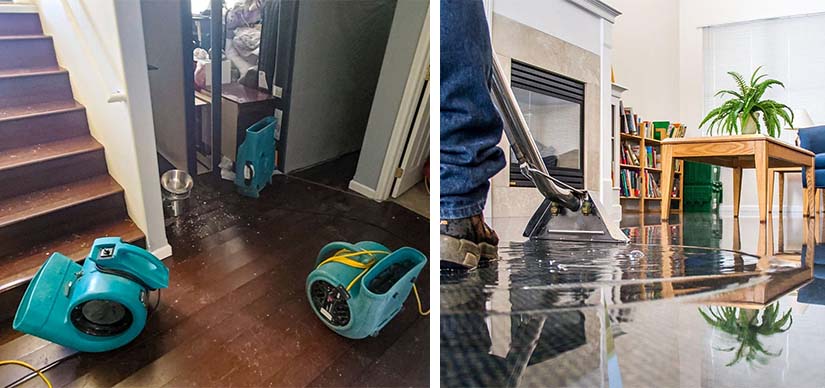When flood damage occurs to your Temecula, California, home or place of business, it can be upsetting and intimidating. The aftermath of a flood requires a lot of work, patience, and time to manage.
However, if you follow the right procedures for flood restoration, you might be able to lessen the damage and return your home to the way it was before the flood.
This post will cover the crucial steps to take for flood restoration in Temecula, including floor restoration and flood repair.
Step 1: Ensure Safety First
Before starting any flood restoration in Temecula, make sure you and those around you are safe. Be cautious and wait to enter your property after flood damage in Temecula until you are sure it is safe to do so.
Turn off the primary power source before touching any electrical devices or wires, and then wait for a qualified electrician to examine them.
Floodwater may contain dangerous substances, such as sewage and chemicals, so wear protective clothing, such as gloves, boots, and masks, to prevent contact with polluted water and debris.
The following are additional suggestions to ensure safety during flood cleanup:
- Before entering the property, be sure to turn off the gas and water.
- Never stand on wet or damp surfaces because they could be slick and dangerous.
- When using power tools and other equipment, exercise caution, and follow all safety regulations.
Step 2: Document the Damage
Before beginning the cleanup process and flood restoration in Temecula, it is important to document the damage for insurance purposes.
Take photos and videos of the damage before you start cleaning up. This will help you with insurance claims and provide evidence of the extent of the flood damage in Temecula.
Make sure to document everything, including water levels, damaged areas, and any personal belongings that were affected.
Here are some additional recommendations for recording flood damage:
- Take photos and videos from multiple angles and distances to capture the full extent of the damage.
- Make a list of all damaged items, including their value and any receipts or other proof of ownership.
- Keep all documentation and records in a safe place, such as a waterproof container or cloud-based storage.
Step 3: Remove Standing Water
The longer water stands on your property, the more flood damage it can cause. It is important to remove all standing water as soon as possible, even if it seems insignificant, as it can lead to mold growth and other problems.
The best way to remove standing water is to pump it out using a wet vacuum, sump pump, or other water extraction equipment.
Other suggestions for getting rid of standing water are as follows:
Start by removing any debris, such as fallen branches or other objects, that may be obstructing the flow of water.
- Use caution when removing water from basements or other below-grade areas, as the water pressure can cause walls or floors to collapse.
- Dispose of water properly, following all local regulations and guidelines.
Step 4: Dry Out the Area
After water extraction, the next step in flood restoration in Temecula is to dry out the affected area.
To encourage air circulation and aid in drying out the affected area, turn on fans, and dehumidifiers, and leave windows open. It is important to remove as much moisture as possible to prevent mold and mildew growth.
Here are some additional pointers for drying out the affected area:
- To hasten the drying process, use special equipment like air movers and dehumidifiers.
- Remove any wet or damp materials, such as carpets, padding, and insulation, that cannot be dried out quickly.
- Use a moisture meter to monitor the moisture levels in the affected area.
Step 5: Remove Damaged Materials
Remove any wet or damaged items, including carpets, drywall, insulation, and furniture, after the area has dried.
To prevent them from contaminating other areas, dispose of them properly. Porous materials that may have been harmed by the floodwater should be removed because they can harbor bacteria and mold.
Here are some additional suggestions for getting rid of damaged materials:
- Wear protective gear such as gloves, boots, and masks when removing damaged materials, as they may contain hazardous materials.
- Sort damaged materials into different categories for disposal, such as recyclable materials and hazardous waste.
- Use proper disposal methods and follow all local regulations and guidelines.
Step 6: Disinfect and Clean
After removing any damaged materials, it’s essential to thoroughly clean and disinfect the affected area.
Since bacteria, viruses, and other dangerous microorganisms can be found in floodwater, it’s crucial to use disinfectants to get rid of any lingering germs.
Use specialized cleaning tools to reach hard-to-reach areas and thoroughly clean all surfaces, including walls, floors, and furniture.
The following are additional cleaning and disinfection suggestions:
- Use a cleaning service or a disinfectant recommended by the Centers for Disease Control and Prevention (CDC).
- When cleaning, put on gloves and protective clothing to protect yourself from harmful bacteria and chemicals.
- Follow all local laws and regulations and properly dispose of cleaning supplies.
Step 7: Repair Structural Damage
It is essential to repair structural damage to your property as soon as possible, such as a collapsed roof or walls.
Damage to your property’s structure may jeopardize its stability and safety and necessitate professional assistance.
Consult a structural engineer or licensed contractor to evaluate the damage and make repair suggestions.
Additional tips for repairing structural damage include:
- Do not attempt to repair structural damage on your own, as it can be dangerous and may cause further damage.
- Work with a licensed and insured contractor or structural engineer to ensure the repairs are done safely and correctly.
- Keep all receipts and documentation related to repairs for insurance purposes.
Step 8: Test for Mold
Mold can begin to grow within 24-48 hours after a flood, and it can cause serious health problems if left untreated.
After completing the cleanup process, it is important to test for mold to ensure that it has not started to grow in the affected area.
Hire a professional mold remediation service or use a DIY mold testing kit to test for mold.
These are some additional recommendations for mold testing:
- Look for signs of mold growth, such as discoloration or musty odors.
- Use a mold testing kit or hire a professional mold remediation service to test for mold.
- If mold is detected, hire a professional mold remediation service to remove it safely and effectively.
Step 9: Restore Utilities
Water, gas, and electricity are frequently disconnected from or turned off after a flood. Utility restoration is necessary to make sure your home is secure and operational before you move back in.
To have them inspect your property and restore service, get in touch with your utility provider.
For restoring utilities, additional advice is as follows:
- Do not attempt to restore utilities on your own, as it can be dangerous and may cause further damage.
- Work with your utility provider to ensure that your property is safe and ready to receive service.
- Keep all documentation related to utility restoration for insurance purposes.
Step 10: Prevent Future Flood Damage
Preventing future flood damage is essential to protecting your property and your family. Take steps to reduce the risk of future floods, such as installing flood barriers or flood vents, and keep your property maintained and in good condition.
Make sure to review your insurance policy regularly and make any necessary updates to ensure that you have adequate coverage.
Other recommendations for avoiding further flood damage include:
- Maintain clear gutters and downspouts to avoid water accumulation and flooding. Install a backup generator or a sump pump to prevent flooding on your property.
- To ensure you have enough coverage, review your insurance policy frequently and make any necessary updates.
Conclusion
Flood restoration in Temecula can be a challenging and drawn-out process, but following the right steps can aid in a speedy and secure recovery.
You can lessen the effects of a flood and safeguard your home and family by being safe, documenting the damage, removing standing water, drying the area out, removing damaged materials, cleaning and disinfecting, repairing structural damage, testing for mold, restoring utilities, and avoiding further flood damage in Temecula.
It is important to keep in mind that flood restoration can be a complex process, and it is often best to seek professional help to ensure that the job is done safely and effectively.
There are many companies for flood restoration in Temecula that specialize in flood damage restoration and have the necessary equipment and expertise to restore your property to its pre-flood condition.
With the right approach and help from professionals, you can get back on track after a flood and protect your property for years to come.



